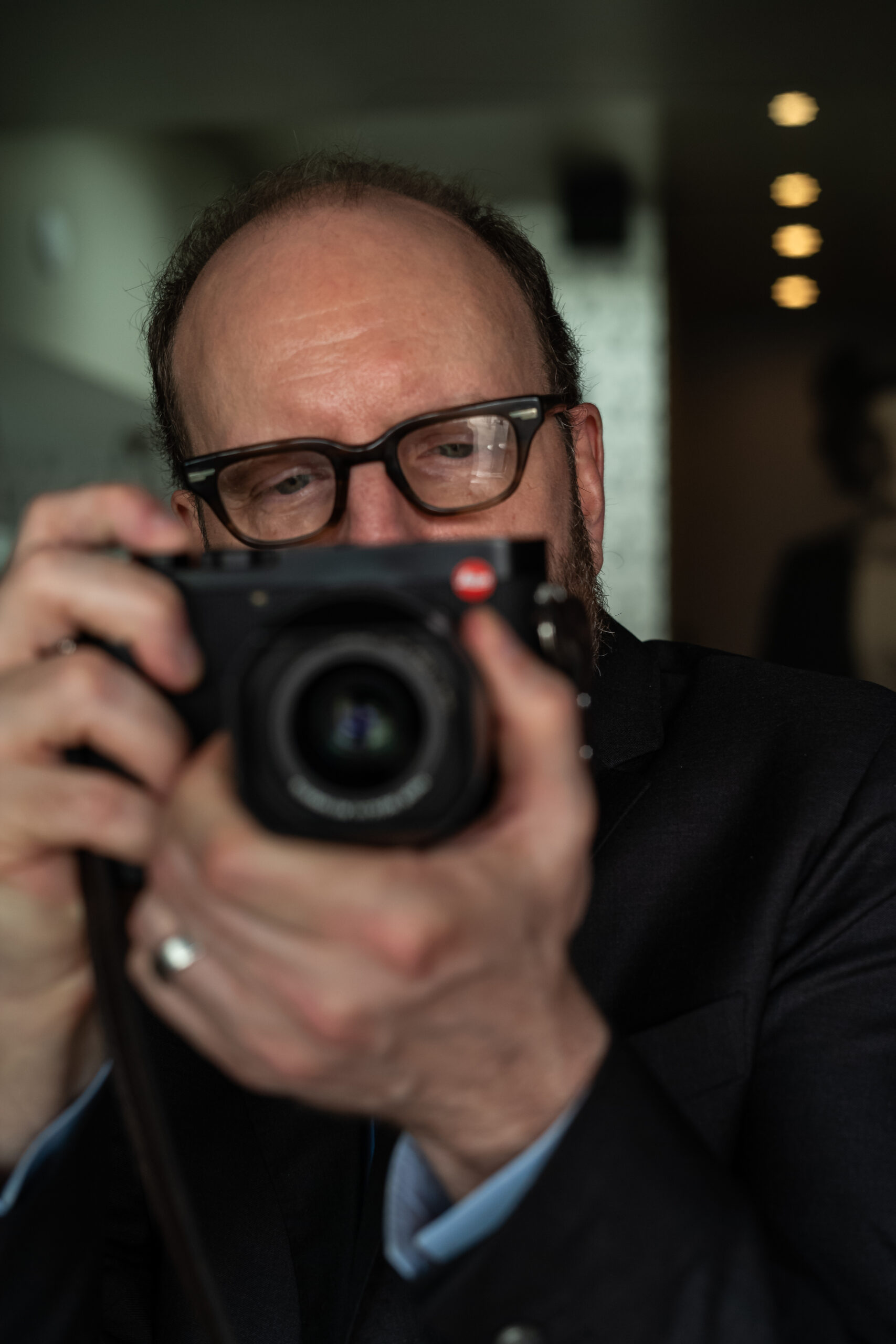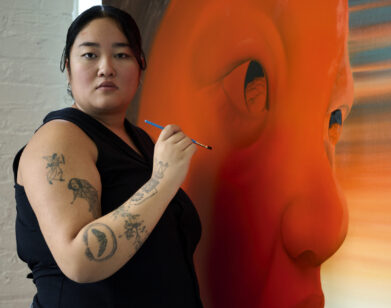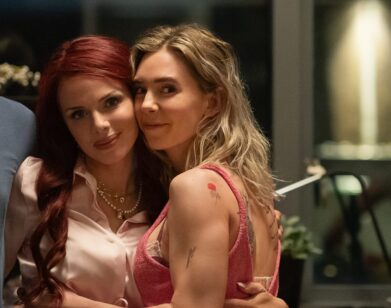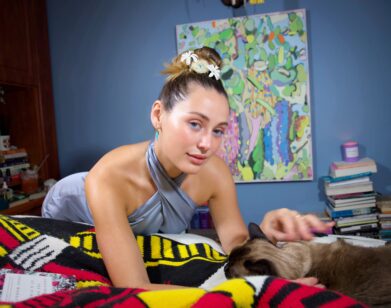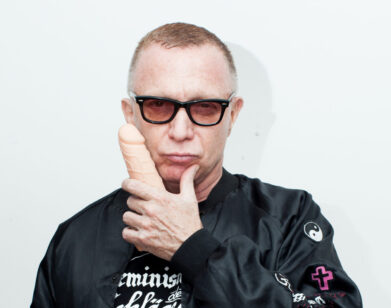DIRECTOR
Steven Soderbergh and David Koepp On Their Big Ghost Story Gambit
When Steven Soderbergh approached the screenwriter David Koepp to collaborate for the second time in five years, it was to make a movie utterly in keeping with Soderbergh’s directorial legacy: brazen, experimental, and totally distinctive. Presence, which premiered a year ago at Sundance and releases wide this Friday, upends the conventions of the single-location haunted house genre by designating the camera as the ghost itself, following the increasingly disturbing breakdown of one unlucky family from its rolling point of view. The nail-biting feature, starring Lucy Liu, Chris Sullivan and Julia Fox in a flashy appearance as the realtor, wastes none of its slim, 85-minute runtime. “I don’t know if liberating is the right word, but boy, it’s the simplest idea I’ve ever come up with,” Soderbergh joked when he called up Koepp from London last week. In conversation, the two got talking about George Clooney, their reading habits, and how they worked together to build that persistent, palpable sense of dread.
———
STEVEN SODERBERGH: Is anybody going to read this?
DAVID KOEPP: I’m going to treat it like a real interview. You and I met not long after I’d written my first couple movies, and you’d made Sex, Lies, and Videotape. We’ve been doing this for maybe 75 years between us, so I thought that gives us kind of a unique perspective where I could ask questions you’ve maybe never heard before.
SODERBERGH: Oh boy.
KOEPP: Here’s the first one: What’s George Clooney really like?
SODERBERGH: Well, shockingly, I’m going to answer it, really.
KOEPP: Really? Okay.
SODERBERGH: He has many of the fine qualities that he portrays on screen. I’m really angry at his success in the booze business.
KOEPP: Well, it is annoying. To do both seems in poor taste. To do both with great success is tough. I didn’t really care about your answer to that, I was just proud of the fact that it was witty. My other alternative is, where do you get your ideas?
SODERBERGH: Well, as it turns out, from you.
KOEPP: At this moment I’m at our house in Amagansett, New York where there was frost on the grass this morning and it was gorgeous. What ugly, low-rent part of the world are you living in?
SODERBERGH: I’m in London trying to finish our third collaboration that will follow closely on the heels of our second collaboration, which we’re here to excavate today.
KOEPP: Before we get to that, I wanted to set the characters, who are, in this case, you and me. We’ve known each other 35 years, but only worked together since 2020. I’m quite proud of each of the three movies we’ve done now, and I’m not comfortable saying that privately so I thought I would say it in a public forum. There were two movies in a row, Presence being one, where I never visited the set. Part of that was due to location or the writers’ strike or various other circumstances. But also, just as I’ve gotten older, I really dislike going to set. I don’t like to watch the sausage being made. I feel people have to have freedom to do their thing and not feel like the writer’s there being a word cop. Do you like having a writer on the set? Or do you secretly prefer peace and quiet?
SODERBERGH: I always encourage it, because stuff does come up. But you’re not the only writer I’ve worked with who has expressed deep disinterest in being on set. When I asked Paul Attanasio on The Good German if he wanted to be on set he said, “I can’t imagine anything more boring.” You and I are not prone to walk onto set with scripts that aren’t in their final form. That has a lot to do with it. Plus, in our case, you get to see the cut stuff, if not that night, the next day. You can weigh in and say, “Hey, you missed that.”
KOEPP: I’d say I haven’t been an active “Oh, I can’t wait to go to the set guy” for 15 or 20 years. I remember I did three movies with Brian De Palma in the ’90s, and I used to go quite a bit. But Brian and I are very different human beings and see things differently. So invariably if I went to the set and I pictured the door being on the right, it was on the left. It was always fundamentally different from what I saw, and therefore wrong. Snake Eyes was the third one, and I asked him, “Do you want me here?” And he said, “Oh god, no.” He said, “You sit there with that look on your face. It’s awful.” I said, “Great. I’m going to the airport.” Most of the time, it’s not appropriate to express any opinions I have.
SODERBERGH: But it must be deeply frustrating if you’re in a situation where you feel it’s being made worse on set.
KOEPP: I always think that—even movies that are clearly far better than the script I wrote for them. I see it and hear it in my head a certain way, but it’s not going to be that way.
SODERBERGH: Right. There’s different, and then there’s worse.
KOEPP: They’re the same to me. It calls for a great deal of open-mindedness. I start to come around after a cut or two because now it’s its own thing. This has happened with us where I’ll give you a note on the first cut of a scene that I completely retract after seeing it two or three times, because it takes a while to move my thinking. What’s changed in the way you approach things on Presence as opposed to Sex, Lives, and Videotape? Not in terms of aesthetic decisions made, but the process as a whole.
SODERBERGH: Well, I can filter more quickly. You’re shrinking what it could be from an almost infinite set of variables down to what it wants to be. The process of eliminating all those other versions that aren’t optimal only advances through being on the floor and going through it. There’s no real shortcut to getting better at that specific aspect. So I just filter faster now than I did then. Sometimes a specific project will really move you downfield, like The Knick, which was a big step forward of just pure filtering out the bad versions.
KOEPP: That was a television show. It did three seasons. How many episodes per season?
SODERBERGH: Two seasons, 10 episodes.
KOEPP: So 20 hours of material. That’s an enormous amount. How long would you take per episode? How many days would you shoot?
SODERBERGH: Seven days per episode.
KOEPP: That is forced concision.
SODERBERGH: Absolutely.
KOEPP And does that apply to every stage of the process? Or mostly shooting?
SODERBERGH: I think I’m better at the little minor recalibrations that we’ve made, either during the shoot or in the post. I’m faster at recognizing issues than I used to be. It used to take me a lot longer to see the problem and solution. I always worry when the gaps between films for a filmmaker who’s got a body of work get longer and longer between films. I feel like it should be going the opposite way. You should be getting better at getting stuff made and moving on to the next, but that’s my metabolism.
KOEPP: In the early stuff I would write or especially direct, there’s a sense of obligation to each phase. Then you realize after you do it a couple of times, “I don’t need to get in the van and go see that stuff. That’s a waste of four and a half hours. I’m not going to do it.”
SODERBERGH: Absolutely. In concert with the pure creative filtering that goes on, understanding how to use the psychic real estate that you have and where to apply attention is another thing that I think you learn. On the one hand, everything matters. On the other hand, not everything matters in the same way and to the same extent. You can’t treat every single creative decision that you’re going to make at Code Red. You just can’t. I hire people who are obsessive on my behalf so that I can guide them and I don’t have to be as obsessive as they are. I don’t want to micromanage them. I try to be smart about what parts I need to be obsessive about, and usually it’s the story. But I’m better now apportioning my focus where it needs to be and not having everything hit me with the same velocity.
KOEPP: I have noticed that you, both in our work and your work with cast and crew, are not interested in doing everybody’s job except those jobs that you have actually taken over. But I heard you say to an actor once who had a question about something, “Well, I hired you because I like what you do. Why don’t you do what you do, and then I’ll react.” As opposed to trying to guide somebody through something or have your hands all over it, I appreciate that the notes you give on scripts are if something could work better. It’s not just to make it different. People really respond well to, “I get to do my job, and I’m guided. Someone’s in charge because someone has to be, but somebody doesn’t have their hands all over my keyboard.”
SODERBERGH: My view is that, ultimately, everything is the director’s fault, so I also don’t get emotional when things turn out differently than what I asked for. I don’t want to burn calories on anything but, “Okay, how do we solve this?” I’m all about the future.
KOEPP: Speaking of the future, Presence is our movie coming out in January. The first thing you said was, “I have an idea for an aesthetic approach. I want to do a ghost story and I want to do the whole thing from the point of view of the ghost.” I was immediately intrigued because it gets to a couple structural ideas that I really like, the number one being to limit my choices. I’ve always felt the world is too big. When anything can happen and anybody can be in it, it’s overwhelming. So to say, “No, the whole thing takes place in three days,” or, “It’s all in one location,” or in this case, “It never leaves the house because it can’t and we can only see what it sees,” was a really exciting idea. You wrote some pages as an example, and I felt like, “This is great. I get it. It’s a family, a house, some secrets, and this rigorous point of view.” Specifically, did you find the filmmaking freeing, constraining, maddening? Did you ever want to say, “Fuck it, I need a closeup”?
SODERBERGH: I don’t know if liberating is the right word, but boy, it’s the simplest idea I’ve ever come up with. The only two things I was anxious about were, one, there was no plan B, so if it doesn’t work you’ve got a real problem. The other was a potential problem that I felt confident would not end up to be a problem, which is our primal urge to see a reverse, a point of view shot. There’s a really strong impulse on the part of the viewer to look into the eyes of the protagonist. Most films in which the point of view is that of an actual person, I start to get frustrated at a certain point that I can’t see the face of the person this stuff is happening to. I was somewhat convinced that once the audience understood the concept, that desire would never arrive because they know there’s nothing to cut to. Based on the response that we’ve gotten, I think that’s been the case. They don’t have that urge to turn around because they know there’s nothing there.
KOEPP: What surprised me from the first cut scene I saw was that the fly-on-the-wall aspect was so strong. It lent this reality to the situation. It’s a real family, real teenagers, real problems in a real location. Because we are voyeurs, we’re watching it from another room, from near them, from inside a closet. It just heightened reality in a way that I didn’t expect.
SODERBERGH: Our innate voyeurism when you start seeing the images is powerful. You could read it and understand the gimmick, but when you start to really feel the implications of that by seeing an image, it goes somewhere else. By design, the movie is not overly long. We both felt there was a limit to what you could do with this idea before it starts getting stupid or you have to do things that are just not possible. We were bumping up against keeping it real and not padding it out by making it exist in some alternate universe.
KOEPP: Also, our desire to see something else might come back. If it was 100 minutes, we might be like, “Enough already. Can we have a third act where they run outside and it’s regular?”
SODERBERGH: Whether the story is this or something more complicated, there does reach a saturation point for the viewer.
KOEPP: The movie is shot stunningly in one camera setup. Some can be short and not terribly difficult to do, but others look horrendously difficult. In terms of minutes, what were the longest takes you did?
SODERBERGH: The longest take is the sort of penultimate shot in the film, and the second longest is the shot that comes just before it. But the big shot, the climax, is about 10 minutes.
KOEPP: 10 minutes long. It starts upstairs, downstairs, back upstairs.
SODERBERGH: The stairs were a challenge. The rig isn’t that heavy. The whole thing with the camera on is probably 10 or 12 pounds.
KOEPP: What is it, specifically?
SODERBERGH: It’s a Sony A7 camera mounted on a small Ronin stabilizer with two handles sort of on either side of the camera. So it’s not heavy, which is great, except when you get to minute seven and you’re holding it out from your body and your arms start to shake. There were a couple of takes in that big shot where we got really far in and I made mistakes. I had to call cut and we had to rerack and start over again. Actually, the hardest thing for me, and one of the reasons that we tried to shoot chronologically, was making clear that it was learning how to look at things while the movie progressed. As the movie goes on, it gets sort of better at figuring out where it should be putting its attention.
KOEPP: The character of the presence.
SODERBERGH: It was just getting better at eavesdropping. And then also the big one for me was a couple of times, I broke takes because I anticipated when someone was going to move and didn’t build in what I felt was the appropriate lag time if you were seeing something for the first time.
KOEPP: That’s such an ingrained cameraman. When people see a movement, the movement starts, then they look. You’re doing the opposite of what you’ve been doing for the last several decades, which is not good camera work. It’s real, because it’s a character.
SODERBERGH: I made a few mistakes. Technically I lagged a little bit, but not enough. So yeah, I would bust a take and just go, “Sorry, we’ve got to go again.” It was very intimate, my relationship with the cast in this case.
KOEPP: Did they feel enormous pressure to not blow a line seven minutes in, for example?
SODERBERGH: If they ever did, I don’t remember it. I only remember me busting a take. We got through the end of a fairly long take, looked at it back and agreed, “Let’s do another one. I think we can all do that better.” They were so prepared. We would rehearse and block a fair amount because I didn’t want to blow takes.
KOEPP: I’ve seen the movie a number of times with audiences because it’s been in a few festivals, and one thing I notice is the silent intensity of the crowd watching it. It’s not a gory film, it’s not full of jump scares, but it is an intense movie. That creation of atmosphere is probably the most amorphous and difficult to describe aspect of a director’s job. Tell us how you did that.
SODERBERGH: If people are being attentive, it’s largely driven by the method of the storytelling, which is demanding a lot of you in terms of backfilling the story and the relationships. You’re getting a piece of things, but you rarely get the whole piece of something. Very early on, there’s an understanding that they’re really going to have to follow what everybody’s saying closely if they want the maximum amount of context for what they’re experiencing. When the audience realizes that there’s real danger afoot in this house and who is in danger, the sense of dread starts to really build.
KOEPP: That’s the very word I was going to use. There is a palpable sense of dread. Again, I’m trying to nail you down on specifics. Is that lighting? Is that music? Is that performance? Story content?
SODERBERGH: Yeah, but honestly, I think it’s primarily your execution of the writing based on that method of releasing information. It is a lifelong process that’s specific to every film. You’re always surprised when people don’t understand something that seems clear and you’re always surprised when something you thought was pretty subtle is way out in front of you.
KOEPP: The wonderful part of it is the mystery. You go in convinced that they won’t be able to follow this byzantine portion of the plot that you can barely follow yourself. They get that no problem, but they don’t understand that the main characters are married. And you’re like, “What are you talking about?” That I kind of enjoy.
SODERBERGH: It keeps you scared and it keeps you alert. Like you said, it keeps it from feeling formulaic.
KOEPP: The times I have tried that, unconsciously, they rebel and don’t do at all what I want. I get my ass kicked. There is a very intense experience to be had in Presence that I find quite difficult, particularly in the last 10 minutes. One of our first screenings, which was Sundance, had maybe 600 or 700 people in the crowd. Toward the end a guy walked out with 10 minutes left. I figured, “Well, it’s a festival. One walkout’s not so bad.” It turned out a reporter that was covering it asked him why he was leaving. And he said, “I can’t take this much intensity at this hour of the night.” And I just thought, “That’s a walkout I’ll take.” As you move along in your career, is there a phase where you find yourself most content? I will tell you mine, which I view as coming up with the story and the first two or so drafts. I am in the zone when it’s going well. I get up in the morning excited about my days. Everything I do after that for the movie feels like obligatory drudge work. Is there a phase like that for you where you’re most comfortable?
SODERBERGH: Editing.
KOEPP: Why?
SODERBERGH: It’s the reward. It’s endlessly fascinating. It’s important not to get paralyzed by the possibilities and to stay kind of focused.
KOEPP: Because the world’s too big, right?
SODERBERGH: Exactly. The power of it is just continually amazing to me. You can alter the core intent of something by moving a couple shots around and taking a couple lines out. You can make something mean what it didn’t mean when it was conceived. It’s really wild.
KOEPP: All right, I want to wrap it up like Ezra Klein would. What are three books you’d recommend?
SODERBERGH: I just read Al Pacino’s memoir and really enjoyed it. It had a nice sort of sonorous aspect to it. I wish he’d written it earlier before we worked together because I would’ve had a lot more questions. The book I read before that, a big contrast, was the new Ta-Nehisi Coates book, The Message.
KOEPP: Oh, right.
SODERBERGH: Which is generating a lot of conversation, as it should. I also read a funny novel called Help Wanted by Adelle Waldman about some people who work at one of those big box department stores on the outskirts of a small town. It’s about this group of people over the course of a couple of weeks who work at this discount store. It was very well-observed, I thought.
KOEPP: That sounds great. And that’s a novel?
SODERBERGH: Yep.
KOEPP: A novel, some nonfiction, and a memoir. Nice mix.
SODERBERGH: I try to mix it up.

